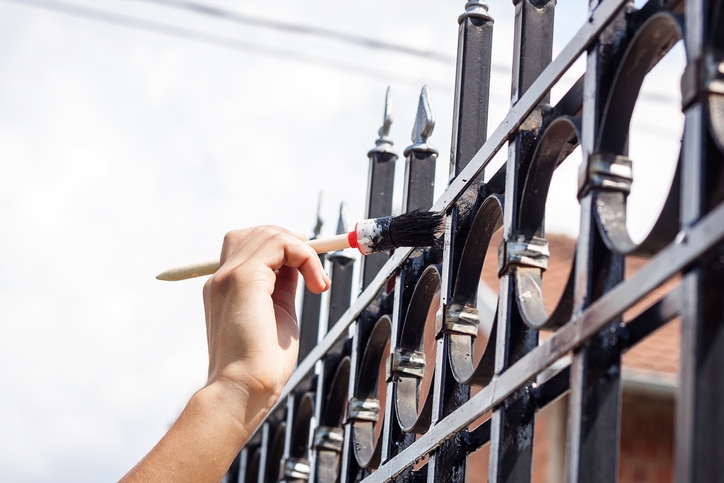Your fence protects and beautifies your home, so how do you maintain it? You can maintain its appearance and integrity by painting or staining, depending on the type and condition.
A well-painted fence serves multiple purposes. It provides a protective barrier against weather elements, preventing wood rot and rust, thus extending the fence’s lifespan. A fresh coat of paint can enhance the fence’s appearance, adding to the overall curb appeal and aesthetic value of a property.
A unique fence can transform an outdoor space by serving as a stylish backdrop for landscaping, creating a cohesive and attractive environment. It can reflect personal taste, complement garden themes, and even create focal points with creative designs or color choices. A distinctive fence can also offer privacy and define outdoor living areas, making the space more functional and enjoyable.
Preparing your fence for painting
1. Cleaning and sanding
- Removing dirt, mildew, and old paint: Start by thoroughly cleaning the fence to remove any dirt, mildew, or old paint. Use a power washer or a stiff brush with soapy water for effective cleaning. Ensure the fence is dry completely before proceeding to the next step.
- Importance of a smooth surface: Sand the fence to create a smooth surface, which helps the paint adhere better. Use sandpaper or an electric sander to remove rough spots, splinters, and any remaining old paint. This step ensures a uniform finish and extends the longevity of the paint job.
2. Repairing and priming
- Fixing any damages or loose boards: Inspect the fence for any damages or loose boards. Replace or repair any broken or damaged parts. Secure any loose boards with nails or screws to ensure the fence is sturdy and ready for painting.
- Applying primer for better paint adhesion: Apply a high-quality primer to the fence, especially if the wood is bare or if you’re making a significant color change. Primer helps the paint adhere better and provides a more uniform color. Allow the primer to dry completely before applying the final coat of paint.
Unique painting ideas for your fence
1. Bold and bright colors
- Choosing vibrant colors to make a statement: Opt for eye-catching hues like turquoise, bright yellow, or fuchsia to create a striking visual impact.
- Tips for using bold colors effectively: Balance bold colors with neutral accents and consider the overall theme of your garden or yard to maintain harmony.
2. Gradient or ombre effect
- How to create a gradient effect: Blend multiple shades of a single color from light to dark, starting at the top or bottom of the fence.
- Best color combinations for an ombre look: Blue to teal, pink to purple, or yellow to orange transitions can create a beautiful gradient effect.
3. Geometric patterns
- Designing and painting geometric shapes: Use tape to outline triangles, squares, or hexagons and fill them in with contrasting colors.
- Using stencils for precision: Employ stencils to ensure clean, crisp lines and uniform shapes in your geometric design.
4. Nature-inspired designs
- Incorporating floral and botanical patterns: Paint flowers, leaves, or vines to bring a touch of nature to your fence.
- Painting landscapes or nature scenes: Create scenic vistas or garden motifs that complement your outdoor space.
5. Murals and artwork
- Creating a mural on your fence: Plan a large-scale design that tells a story or showcases a favorite theme.
- Tips for planning and executing a mural: Sketch your design on paper, then transfer it to the fence in sections, using a grid if needed.
6. Mixed media fence art
- Combining paint with other materials (e.g., metal, wood): To enhance your painted design, add metal sculptures, wooden elements, or mosaic tiles.
- Ideas for adding texture and dimension: Use raised surfaces, layering techniques, and different materials to create a tactile experience.
7. Striped and chevron patterns
- Techniques for painting stripes and chevrons: Use painter’s tape to mark off even stripes or chevron angles and paint within the lines.
- Color schemes that work well with these patterns: Classic black and white, nautical blue and white, or vibrant multicolor schemes.
8. Incorporating chalkboard paint
- Using chalkboard paint for a versatile, changeable fence: Apply chalkboard paint to sections of your fence for drawing or writing messages.
- Fun ways to use a chalkboard fence: Create a calendar, a drawing area for kids, or a space for inspirational quotes.
9. Stenciled designs
- Choosing and using stencils for detailed designs: Select stencils that match your desired theme and use spray paint or a brush for application.
- Popular stencil patterns for fences: Mandalas, floral motifs, or intricate geometric patterns.
10. Distressed and weathered look
- How to achieve a distressed, rustic finish: Use sanding techniques, layering paint, and applying a wash to create a weathered effect.
- Techniques for weathering your fence: Dry brushing, applying a patina, or using a crackle finish to add character and age
Practical tips for painting your fence
1. Choosing the right paint
- The best types of paint for outdoor use are exterior acrylic latex paint or oil-based paint, which provide excellent weather resistance.
- Ensuring durability and weather resistance: Look for paints specifically formulated for outdoor use, offering UV protection and mildew resistance.
2. Using Proper Tools
- Recommended brushes, rollers, and sprayers: Use high-quality synthetic brushes for water-based paints and natural bristle brushes for oil-based paints. Rollers can speed up large areas, while sprayers offer a smooth, even finish.
- Quality tools are important for a professional finish. Invest in good tools to ensure even coverage, reduce streaks, and achieve a more durable finish.
3. Weather considerations
- The best times of year to paint your fence are during mild, dry weather, ideally in late spring or early fall. Avoid extreme heat, cold, or high humidity.
- How to protect your work from the elements: Check the weather forecast and avoid painting if rain or strong winds are expected. If necessary, use tarps or covers to shield your work.
4. Maintenance and touch-ups
- Keeping your fence looking fresh over time: Regularly clean your fence with mild soap and water to remove dirt and mildew.
- Tips for quick touch-ups and repairs: Keep leftover paint for touch-ups, addressing chips or peeling as soon as they appear to prevent further damage.
Conclusion
Painting your fence is not only a practical way to protect it from the elements but also an opportunity to get creative and personalize your outdoor space. Don’t hesitate to experiment with colors and finishes that reflect your style and complement your home.
If you’re unsure where to start or want a flawless finish, consider reaching out to our paint experts at Custom Painting, Inc., who can bring your vision to life with their expertise and high-quality workmanship. Call us at 925-294-8062 or use our contact page for free consultation and estimate. We look forward to working with you!



